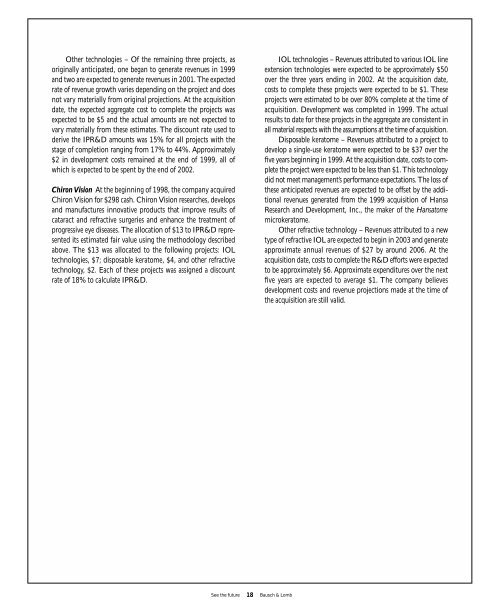You also want an ePaper? Increase the reach of your titles
YUMPU automatically turns print PDFs into web optimized ePapers that Google loves.
Other technologies – Of the remaining three projects, as<br />
originally anticipated, one began to generate revenues in <strong>1999</strong><br />
and two are expected to generate revenues in 2001. The expected<br />
rate of revenue growth varies depending on the project and does<br />
not vary materially from original projections. At the acquisition<br />
date, the expected aggregate cost to complete the projects was<br />
expected to be $5 and the actual amounts are not expected to<br />
vary materially from these estimates. The discount rate used to<br />
derive the IPR&D amounts was 15% for all projects with the<br />
stage of completion ranging from 17% to 44%. Approximately<br />
$2 in development costs remained at the end of <strong>1999</strong>, all of<br />
which is expected to be spent by the end of 2002.<br />
Chiron Vision At the beginning of 1998, the company acquired<br />
Chiron Vision for $298 cash. Chiron Vision researches, develops<br />
and manufactures innovative products that improve results of<br />
cataract and refractive surgeries and enhance the treatment of<br />
progressive eye diseases. The allocation of $13 to IPR&D represented<br />
its estimated fair value using the methodology described<br />
above. The $13 was allocated to the following projects: IOL<br />
technologies, $7; disposable keratome, $4, and other refractive<br />
technology, $2. Each of these projects was assigned a discount<br />
rate of 18% to calculate IPR&D.<br />
See the future 18 <strong>Bausch</strong> & <strong>Lomb</strong><br />
IOL technologies – Revenues attributed to various IOL line<br />
extension technologies were expected to be approximately $50<br />
over the three years ending in 2002. At the acquisition date,<br />
costs to complete these projects were expected to be $1. These<br />
projects were estimated to be over 80% complete at the time of<br />
acquisition. Development was completed in <strong>1999</strong>. The actual<br />
results to date for these projects in the aggregate are consistent in<br />
all material respects with the assumptions at the time of acquisition.<br />
Disposable keratome – Revenues attributed to a project to<br />
develop a single-use keratome were expected to be $37 over the<br />
five years beginning in <strong>1999</strong>. At the acquisition date, costs to complete<br />
the project were expected to be less than $1. This technology<br />
did not meet management’s performance expectations. The loss of<br />
these anticipated revenues are expected to be offset by the additional<br />
revenues generated from the <strong>1999</strong> acquisition of Hansa<br />
Research and Development, Inc., the maker of the Hansatome<br />
microkeratome.<br />
Other refractive technology – Revenues attributed to a new<br />
type of refractive IOL are expected to begin in 2003 and generate<br />
approximate annual revenues of $27 by around 2006. At the<br />
acquisition date, costs to complete the R&D efforts were expected<br />
to be approximately $6. Approximate expenditures over the next<br />
five years are expected to average $1. The company believes<br />
development costs and revenue projections made at the time of<br />
the acquisition are still valid.



